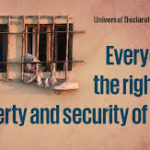
Article 3-Everyone has the Right to Life, Liberty, and Security of Person.
Article below-Reprint from: https://www.standup4humanrights.org/layout/files/30on30/UDHR70-30on30-article3-eng.pdf (30 Articles on 30 Articles)
The first six words of this short article are at the heart of global attempts to end the
death penalty. If it enshrines the right to life, abolitionists argue, how can
state-sponsored killing be justified? As South African Anglican Bishop Desmond Tutu
said, “to take a life when a life has been lost is revenge, not
justice.”
Drafters of the 1948 Universal Declaration of Human Rights (UDHR) had fresh in their minds Nazi concentration camps and state-organized slaughter of millions simply because they were not the “correct” sort of person. Article 3 – and closely related Articles 5 and 9 against torture and arbitrary arrest – were a firm renunciation of Hitler’s belief in the supremacy of the state to control the lives of individuals.
Chilean drafter Hernan Santa Cruz explained that many of the UDHR’s Articles, are based on the belief that “the interests of the individual [come] before those of the state and that the state should not be allowed to deprive the individual of his dignity and his basic rights.”
The right to life has gone on to be one of the core rights accepted by countries; 77 percent of the world’s constitutions include this right, compared to 27 percent of constitutions in effect in 1945, when the UN was founded.
Article 3 is about much more than the death penalty. It is fundamental to enjoyment of all other rights: after all, you have to be alive to exercise free speech, get married, or hold nationality.
This was emphasized in a quasi-legal “general comment” document published in October 2018 by the Human Rights Committee, a body of independent experts that monitors implementation of the International Covenant on Civil and Political Rights, one of the two covenants that expand on the UDHR.
It noted that the obligation to protect, respect and ensure the right to life covers many other issues including modern technologies such as the use of drones in armed conflict. Looking to the future, it said environmental degradation, climate change and unsustainable development represent serious threats to the ability of present and
future generations to enjoy the right to life.
Others have argued that Article 3 embraces many other issues – deprivation of health care that leads to death, extra-judicial killings, even the use of live ammunition by police forces against unarmed protestors.
Antônio Cançado Trinidade, then President of the Inter-American Court of Human Rights wrote that “the arbitrary deprivation of life is not limited to the illicit act of homicide; it extends itself to the deprivation of the right to live with dignity.”
The right to life is amplified in four UN treaties whose stated purpose is to abolish the death penalty, and since 2007 the UN General Assembly has adopted five non-binding resolutions calling for a global moratorium on executions as a step to eventual abolition. “There is no place for the death penalty in the 21st century,” said former UN Secretary-General Ban Ki-moon.
When the UDHR was adopted on 10 December 1948, only 14 countries had abolished the death penalty.
Seventy years on, more than two-thirds of UN member states have either abolished it or no longer actually apply it. Even in countries that have a mandatory death penalty, it is not always enforced by executions. At the end of March 2016, for example, the deputy prime minister of Malaysia announced that 829 persons had been sentenced to death
between 2010 and March 2016 but only 12 executions had taken place during this time.
Most nations that have abolished the use of the death penalty have cited human rights as a main motivator, while the steadily dwindling number of nations that retain the death penalty (88) or actually execute people (39), avoid framing capital punishment as a human rights issue.
Threats to life, however, come not only from state executioners, but sometimes from your neighbor or your partner, from criminal gangs and armed groups, and States have an obligation to protect their citizens.
Killings of women and girls – by their partners, by strangers, by parents who prefer boys – also constitute a particular grave and all-too-common abuse of this fundamental right, and females of all ages still often suffer inadequate legal and At least 39 executions have been carried out in the United States in face of compelling evidence of innocence or serious doubt about guilt.
- Center on Wrongful Convictions
Northwestern University School of Law
physical protection by state authorities and institutions. As Rashida Manjoo, former
UN Special Rapporteur on Violence Against Women put it: “Women subjected to continuous violence are always on ‘death row,’ always in fear of execution.”
ENDS
For more information on the events listed in this advisory, please contact Rupert Colville – +
41 22 917 9767 / rcolville@ohchr.org or Ravina Shamdasani – + 41 22 917 9169 /
rshamdasani@ohchr.org
More details about the events and campaigns linked to the 70th anniversary will be posted on
http://www.standup4humanrights.org/
For more information on the UDHR itself, please visit http://www.un.org/en/universal-declarationhuman-rights/
Tag and share – Twitter: @UNHumanRights and Facebook: unitednationshumanrights
